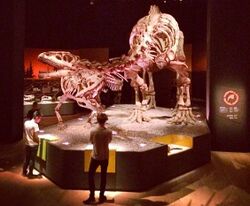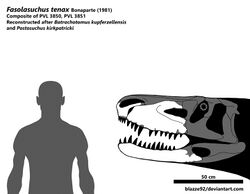Biology:Fasolasuchus
| Fasolasuchus | |
|---|---|

| |
| Fasolasuchus in front of the sauropod Lessemsaurus, in Singapore | |
| Scientific classification | |
| Missing taxonomy template (fix): | Archosauria/Reptilia |
| Clade: | Pseudosuchia |
| Genus: | †Fasolasuchus Bonaparte, 1981 |
| Species: | †F. tenax
|
| Binomial name | |
| †Fasolasuchus tenax Bonaparte, 1981
| |
Fasolasuchus is an extinct genus of loricatan. Fossils have been found in the Los Colorados Formation of the Ischigualasto-Villa Unión Basin in northwestern Argentina that date back to the Norian stage of the Late Triassic, making it one of the last "rauisuchians" to have existed before the order became extinct at the end of the Triassic.[1][2]
Description
Fasolasuchus is likely the largest known "rauisuchian", with an estimated length of 8 m (26 ft)[3] to 10 m (33 ft).[4][5] This would make Fasolasuchus the largest terrestrial predator to have ever existed save for large theropods, surpassing the Cenozoic Barinasuchus, the "rauisuchian" counterpart Saurosuchus at 7 metres (23 ft), and many medium sized theropods as large as Ceratosaurus.[6][7][8] Like Saurosuchus, it had only a single row of caudal osteoderms, unusual among "rauisuchians".[9] It also had a hyposphene-hypantrum articulation that gave the vertebral column extra rigidity. This feature is also seen in several other "rauisuchians" such as Postosuchus as well as saurischian dinosaurs.[10][11]
Phylogeny
Cladogram after the analysis of Nesbitt (2011):[12]
| Paracrocodylomorpha |
| ||||||||||||||||||||||||||||||||||||
Paleobiology
A study on bone microstructure determined that Fasolasuchus had a relatively fast growth rate, similar to most other "rauisuchians", with the exception of Prestosuchus. The same study also determined that the specimen was somatically and skeletally mature, but it wasn't possible to determine sexual maturity: this may be due to taphonomic causes, however the bone cortex was mostly preserved and didn't show the changes in bone matrix or in vascularization that would be expected if the specimen was sexually mature. Alternatively, Fasolasuchus attained sexual maturity contemporaneously to or slightly later than somatic and skeletal maturity (although this growth pattern is today only found in birds, not crocodilians), or there were differences in the timing of maturity of different bones in the same individual, as reported in the tuatara and in some dinosaurs.[7]
References
- ↑ Bonaparte, J. F. 1981. Description de "Fasolasuchus tenax" y su significado en la sistemarica y evolucion de los thecodontia. Revista del Museo Argentino de Ciencias Naturales "Bernardino Rivadavia" 3:55–101.
- ↑ Bonaparte, J. F. (1986). Locomotion in Rauisuchid Thecodonts. Journal of Vertebrate Paleontology 3(4):210-218.
- ↑ Nesbitt, S. J., Brusatte, S. L., Desojo, J. B., Liparini, A., França, M. A. G. D., Weinbaum, J. C., & Gower, D. J. (2013). Rauisuchia. Geological Society, London, Special Publications, 379(1), 241–274. https://doi.org/10.1144/SP379.1
- ↑ Sterling J. Nesbitt (2011). "The Early Evolution of Archosaurs: Relationships and the Origin of Major Clades". Bulletin of the American Museum of Natural History 352: 1–292. doi:10.1206/352.1. https://digitallibrary.amnh.org/handle/2246/6112.
- ↑ Julia Brenda Desojo; Randall B. Irmis; Sterling J. Nesbitt (2013). Anatomy, Phylogeny and Palaeobiology of Early Archosaurs and Their Kin. Geological Society. p. 260. ISBN 978-1-86239-361-5. https://books.google.com/books?id=TN_KBP3vxg4C. Retrieved 14 September 2022.
- ↑ Molnar, Ralph E.; Vasconcellos, Felipe Mesquita de (2016-07-30). "Cenozoic dinosaurs in South America – revisited" (in English). Memoirs of Museum Victoria 74: 363–377. doi:10.24199/j.mmv.2016.74.25. https://museumsvictoria.com.au/collections-research/journals/memoirs-of-museum-victoria/volume-74-2016/pages-363-377/.
- ↑ 7.0 7.1 Ponce, Denis A.; Scheyer, Torsten M.; Cerda, Ignacio A.; Desojo, Julia B. (2023-07-31). "Palaeobiological inferences of "rauisuchians" Fasolasuchus tenax (Los Colorados Fm., Argentina) and Prestosuchus chiniquensis (Santa Maria Super sequence, Brazil) from the Middle-Upper Triassic of South America based on microstructural analyses". Journal of Anatomy. doi:10.1111/joa.13937. ISSN 1469-7580. PMID 37519277. https://pubmed.ncbi.nlm.nih.gov/37519277/.
- ↑ Fawcett, Molly J.; Lautenschlager, Stephan; Bestwick, Jordan; Butler, Richard J. (2023-08-16). "Functional morphology of the Triassic apex predator Saurosuchus galilei (Pseudosuchia: Loricata) and convergence with a post‐Triassic theropod dinosaur" (in en). The Anatomical Record. doi:10.1002/ar.25299. ISSN 1932-8486. https://anatomypubs.onlinelibrary.wiley.com/doi/10.1002/ar.25299.
- ↑ Sulej, T. (2005). A new rauisuchian reptile (Diapsida: Archosauria) from the Late Triassic of Poland. Journal of Vertebrate Paleontology 25(1):78–86.
- ↑ Weinbaum, J. C. and Hungerbüler, A. (2007). A revision of Poposaurus gracilis (Archosauria: Suchia) based on two new specimens from the Late Triassic of the southwestern U.S.A. Paläontologische Zeitschrift 81(2):131-145.
- ↑ Apesteguia, S. (2005). Evolution of the hyposphene-hypantrum complex within Sauropoda. In: Virginia Tidwell, Kenneth Carpenter, eds., Thunder-lizards: the Sauropodomorph dinosaurs. Bloomington. Indiana University Press. pp. 248-267.
- ↑ Nesbitt, S. J. (2011). "The early evolution of archosaurs: relationships and the origin of major clades". Bulletin of the American Museum of Natural History 352: 1–292. doi:10.1206/352.1. https://digitallibrary.amnh.org/handle/2246/6112.
External links
- Fasolasuchus in the Paleobiology Database
- "Fasolasuchus - paleofile.com". http://www.paleofile.com/Pseudosuchia/Fasolasuchus.asp.
Wikidata ☰ Q147645 entry
 |


